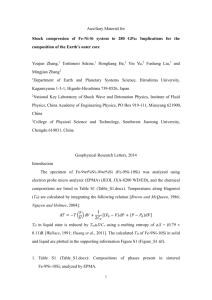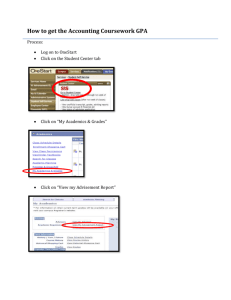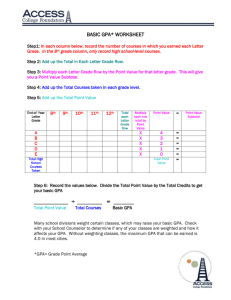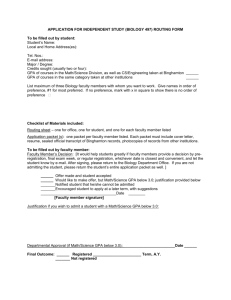Thomsen_Tonny_Talk - SWISS GEOSCIENCE MEETINGs
advertisement
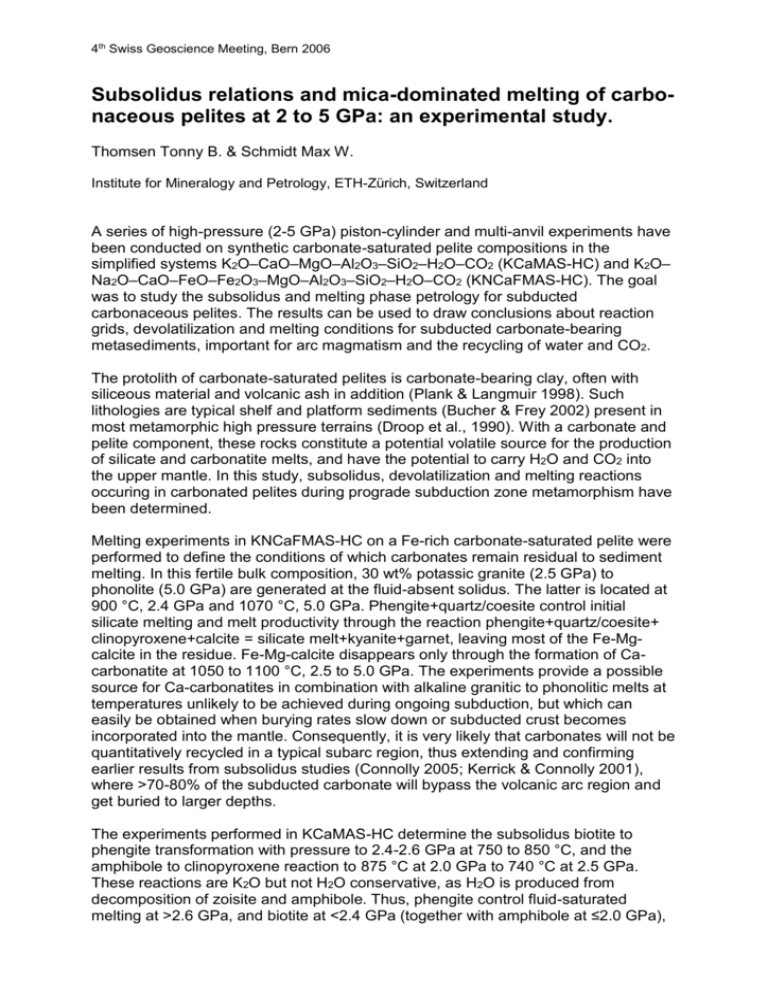
4th Swiss Geoscience Meeting, Bern 2006 Subsolidus relations and mica-dominated melting of carbonaceous pelites at 2 to 5 GPa: an experimental study. Thomsen Tonny B. & Schmidt Max W. Institute for Mineralogy and Petrology, ETH-Zürich, Switzerland A series of high-pressure (2-5 GPa) piston-cylinder and multi-anvil experiments have been conducted on synthetic carbonate-saturated pelite compositions in the simplified systems K2O–CaO–MgO–Al2O3–SiO2–H2O–CO2 (KCaMAS-HC) and K2O– Na2O–CaO–FeO–Fe2O3–MgO–Al2O3–SiO2–H2O–CO2 (KNCaFMAS-HC). The goal was to study the subsolidus and melting phase petrology for subducted carbonaceous pelites. The results can be used to draw conclusions about reaction grids, devolatilization and melting conditions for subducted carbonate-bearing metasediments, important for arc magmatism and the recycling of water and CO2. The protolith of carbonate-saturated pelites is carbonate-bearing clay, often with siliceous material and volcanic ash in addition (Plank & Langmuir 1998). Such lithologies are typical shelf and platform sediments (Bucher & Frey 2002) present in most metamorphic high pressure terrains (Droop et al., 1990). With a carbonate and pelite component, these rocks constitute a potential volatile source for the production of silicate and carbonatite melts, and have the potential to carry H2O and CO2 into the upper mantle. In this study, subsolidus, devolatilization and melting reactions occuring in carbonated pelites during prograde subduction zone metamorphism have been determined. Melting experiments in KNCaFMAS-HC on a Fe-rich carbonate-saturated pelite were performed to define the conditions of which carbonates remain residual to sediment melting. In this fertile bulk composition, 30 wt% potassic granite (2.5 GPa) to phonolite (5.0 GPa) are generated at the fluid-absent solidus. The latter is located at 900 °C, 2.4 GPa and 1070 °C, 5.0 GPa. Phengite+quartz/coesite control initial silicate melting and melt productivity through the reaction phengite+quartz/coesite+ clinopyroxene+calcite = silicate melt+kyanite+garnet, leaving most of the Fe-Mgcalcite in the residue. Fe-Mg-calcite disappears only through the formation of Cacarbonatite at 1050 to 1100 °C, 2.5 to 5.0 GPa. The experiments provide a possible source for Ca-carbonatites in combination with alkaline granitic to phonolitic melts at temperatures unlikely to be achieved during ongoing subduction, but which can easily be obtained when burying rates slow down or subducted crust becomes incorporated into the mantle. Consequently, it is very likely that carbonates will not be quantitatively recycled in a typical subarc region, thus extending and confirming earlier results from subsolidus studies (Connolly 2005; Kerrick & Connolly 2001), where >70-80% of the subducted carbonate will bypass the volcanic arc region and get buried to larger depths. The experiments performed in KCaMAS-HC determine the subsolidus biotite to phengite transformation with pressure to 2.4-2.6 GPa at 750 to 850 °C, and the amphibole to clinopyroxene reaction to 875 °C at 2.0 GPa to 740 °C at 2.5 GPa. These reactions are K2O but not H2O conservative, as H2O is produced from decomposition of zoisite and amphibole. Thus, phengite control fluid-saturated melting at >2.6 GPa, and biotite at <2.4 GPa (together with amphibole at ≤2.0 GPa), 4th Swiss Geoscience Meeting, Bern 2006 defining the solidus to 850-950 °C. Just above the solidus 7-24 wt% metaluminous Krich granite melts are produced through the reactions phengite+zoisite+coesite = silicate melt+clinopyroxene+kyanite (>2.6 GPa) and biotite+zoisite+quartz(±amphibole) = silicate melt+clinopyroxene+kyanite (<2.4 GPa). The liquidus surface is dominated by peritectic melting of zoisite in turn clinopyroxene with increasing temperatures. The experiments suggest that in most subduction zones, CO2 and H2O will be carried to larger depths, as melting occur at temperatures unlikely to be achieved during ongoing subduction. However, the release of H2O through pressurized decomposition of amphibole and zoisite provide a volatile source for arc magma generation in the overlying mantle wedge. REFERENCES Plank, T and Langmuir, CH (1998) The chemical composition of the subducting sediment and its consequences for the crust and mantle. Chemical Geology 145: 325-394. Connolly, JAD (2005) Computation of phase equilibria by linear programming: A tool for geodynamic modeling and its application to subduction zone decarbonation. Earth and Planetary Science Letters 236: 524-541. Kerrick, DM and Connolly JAD (2001) Metamorphic devolatilization of subducted marine sediments and transport of volatiles to the Earth's mantle. Nature 411: 293296.
